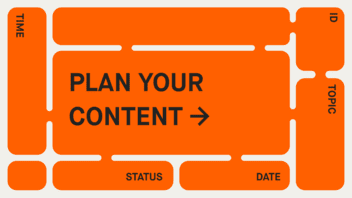One single content creation document brings clarity, stays up to date, and saves a great deal of time during production. It also makes collaboration between agencies, service providers, and companies much easier. At Moccu, we call this framework a 'copybook.'
Copybook: A framework for agencies and companies
In a nutshell
A copybook is a central document used in content creation. It contains the complete content of a website, along with exact guidelines on how that content should be structured and presented.
Creating a copybook isn’t just the agency’s job; service providers and the company itself are directly involved. That’s why a copybook is a valuable tool for every role in the process: the business team, SEO, copywriting, UI, asset production, design, UX, and content management.
Agencies save time. Companies save money. Collaboration is smoother, and time-intensive steps like building a pre-layout can often be skipped entirely.
Our agency clients, including STIHL, Hama and Angelini, are never surprised by the final result. That’s because they’re actively involved and able to give input throughout the process.
Moccu: Your agency for strategic content creation
Looking to create content that delivers measurable results across SEO, paid media, and social? We craft audience-focused content for B2C and B2B that not only earns top rankings in search engines but also drives reach across all channels.
Copybooks: for efficient collaboration
From first draft to final publication, content passes through many hands. To keep the creation process as transparent, consistent, and efficient as possible, we use a copybook in all of our website projects at Moccu.
This single shared document contains finalized copy, modules with character limits, image/video links and captions, and metadata. Each element is clearly structured and easy to find. In short: the copybook contains the full content of each website, along with detailed guidelines for how it should appear.
It’s simple. It’s transparent. And it leads to a clear, consistent result on the live site – making it a powerful collaboration tool for agencies, service providers, and client teams.
Requirements for a copybook
For a copybook to truly support content creation, it must match the production workflow and follow a logical, easy-to-navigate structure. After all, multiple teams – both on the agency and client side – work with this document.
The first step is listing all stakeholders and responsibilities. That way, everyone knows who’s involved and when, and communication becomes faster and more focused. But that’s just the beginning. A strong copybook also needs to meet a few key criteria to make things run smoothly.
The ideal copybook is …
- Clear
Everything should be identifiable at a glance – from H1 headings to character limits for image captions. - Comprehensive
Every relevant detail about the content and its production process needs to be included. - Precise
Unambiguous wording, clear highlights, and targeted comments ensure everyone stays aligned. - Detailed
All entries should be thoroughly specified to leave no room for confusion. - Scannable
Smart use of anchor points and layout help users visually separate sections and navigate intuitively. - Adaptable
Since a copybook evolves throughout the project, it must be easy to update and always kept in sync.
Moccu’s copybook template at a glance
Each content piece is based on a master template and lives in a shared Word document, hosted on a collaborative platform provided by the company.
This setup makes collaboration clear and straightforward. Team members can work together directly in the document, with all communication handled easily through the integrated comment function.
Copybook template: quick start, efficient process
The copybook template comes preloaded with all common modules, such as hero sections, headers, body copy, images, videos, accordions, and more.
If a piece of content is SEO-relevant, the text is first created based on a SEO briefing and then transferred into the copybook. If no SEO briefing is needed, the copy is written directly in the document.
Using a copybook ensures that:
- All stakeholders know which modules are available for a given template
- Modules are used consistently throughout
- The content’s narrative thread stays intact
In addition, the copybook template already includes design specifications, helping to avoid miscommunication. With clear expectations, back-and-forth is reduced and common misunderstandings are kept to a minimum.
One great side benefit: new team members can quickly get up to speed and contribute productively, thanks to the copybook’s built-in clarity and structure.
Challenges of working with a copybook
For the workflow to run smoothly, clear communication is essential – especially since everyone can make edits in the shared document. If something gets misunderstood, version history is a helpful safeguard: it shows exactly who changed what, and when.
At first glance, a copybook can feel overwhelming due to the sheer amount of information. But color coding helps users quickly navigate, identify updates at a glance, and visually separate different types of content.
Rolling out a copybook workflow across companies, agencies, and service providers isn’t always easy. It starts with a clear, shared structure – beginning with a unified folder setup that ensures everyone has access and can work productively together.
That’s why onboarding matters. Introducing the copybook approach early helps employees feel involved and confident using the shared document. Clear guidelines and open collaboration foster mutual understanding and respect across teams – and ensure the copybook remains the go-to reference for all content format decisions.
Benefits of using a copybook in content creation
Why don’t we want to give up our copybook anymore? Because the final version of the copybook mirrors what goes live, and because it makes content creation easier for everyone involved.
The document enables collaborative work between companies, agencies, and service providers. That means clients are never caught off guard by the result – they’re part of the process from the start. That means fewer feedback loops and smoother approval.
Later on, the copybook can be reused – whether during a content refresh or when creating related topics. Once the structure is in place, it’s simple to adapt.
Working with copybooks also means less agency effort and major time savings, since creating a copybook is much faster than building out pixel-perfect mockups for every content block in a design tool.
Naturally, we use copybooks for our own Moccu Insights articles, too.🙂
Any questions? Schedule a meeting now.
Thank you!
We’ll get back to you as soon as possible.








